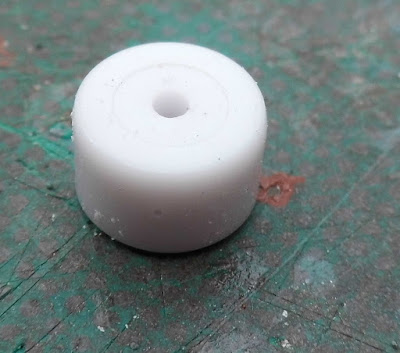 Having recently constructed some coal bins (see How I constructed some coal bins) and a coal yard How I constructed a coal yard) for Beeston Castle station, I decided to add some relevant details to the yard. Consulting the internet, I discovered that many coal yards had sets of scales for weighing the coal, which were purpose-made for the job. So, it seemed sensible for me to find or make some suitable scales.
Having recently constructed some coal bins (see How I constructed some coal bins) and a coal yard How I constructed a coal yard) for Beeston Castle station, I decided to add some relevant details to the yard. Consulting the internet, I discovered that many coal yards had sets of scales for weighing the coal, which were purpose-made for the job. So, it seemed sensible for me to find or make some suitable scales.(see
There were various designs, including this one which, coincidentally, was up for auction at Beeston Market - adjacent to the hypothetical site for my station.
Unfortunately, it had been sold last year and so was no longer available for my scrutiny. I therefore had to estimate the dimensions for my set of scales. I decided that my scales would be far simpler in design.
Three pieces of 3mm square section plasticard were cut - 35mm, 35mm and 25mm long. These were then shaped to fit together in an isosceles triangle.
On top of this triangle, a piece of 20mm x 5mm x 2mm thick plasticard was glued.
Two 23mm long legs were cut from the 3 x 3 square section. Their ends were given a half-round indent with a needle file.
Two three-hole 00 scale wagon wheels were de-flanged .......
..... and glued on to then ends of a 32mm long piece of 3mm OD plastic tube.
The axle and wheels were then glued to the bottom of the legs.
Two 5mm square pieces of 2mm thick plasticard were half-rounded to act as the pivot for the balance arm.
The balance arm (45mm x 3mm x 2mm thick) was cut and glued above the cross-piece. The pivot pieces were then glued either side of this.
A 30mm long third leg was then glued to the third corner of the triangle and three pieces of 2mm x 2mm plasticard (cut from a 2mm thick sheet) were glued to provide struts for the legs. A 20mm piece of 1mm brass rod was glued into a hole at the end of the balance arm and a 6mm disc added to its base.
The disc was made from the wheel of a model skateboard picked up up in my local 50p shop.
The wheel was filed down to half its width, to act as support for the weights on the end of the balance arm.
Another wheel was given a slot with a file to act as a weight.
The scuttle for the coal on the other end of the balance arm was made from a 20mm OD piece of plastic pipe, 30mm in length.
This was cut in half, length-ways and glued (with superglue) to a piece of 1.5mm thick black plasticard. The end of the scuttle was filed to give the distinctive scoop shape.
When the glue had set, the plasticard was trimmed close to the end of the tube with a pair of scissors .....
.... and then sanded to the right profile. A 40mm long piece of 1mm thick black plasticard (3mm wide) was then cut and 1mm holes drilled near each end. This was then fixed to 1mm holes drilled mid way along the scuttle with dress-making pins.
These were glued into place with superglue, before being snipped flush.
The scuttle was then glued to the end of the balance arm.
The scales were given a coat of pale blue acrylic paint, the wheels and weights picked out in black and the scuttle painted light grey. When this paint had dried, a wash of mucky brown paint was applied to simulate light weathering.
I think the scales are (ironically) slightly under scale and so, if I was going to make another set, I would increase the dimensions by around another 25%. However, they will look very much at home in the coal yard at Beeston Castle station (see How I added a coal yard to Beeston Castle).
















































